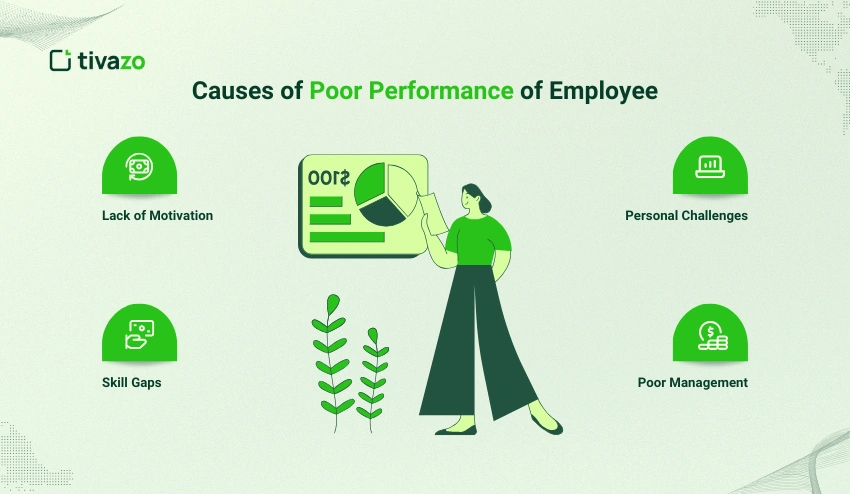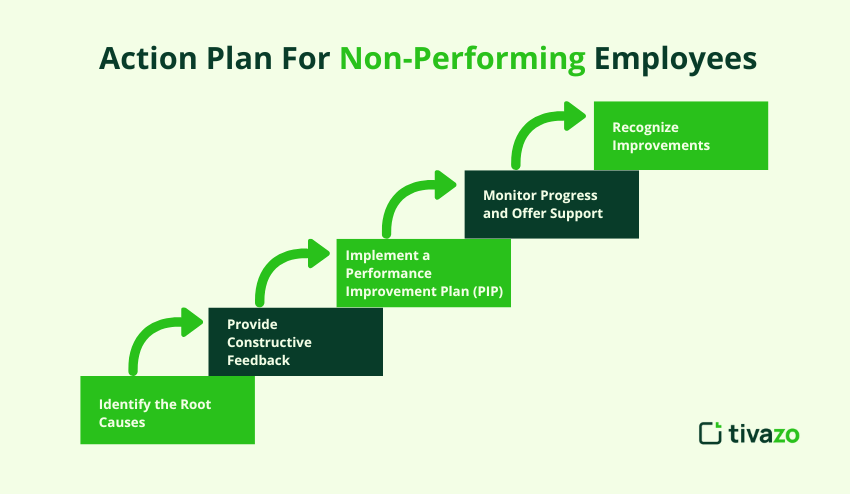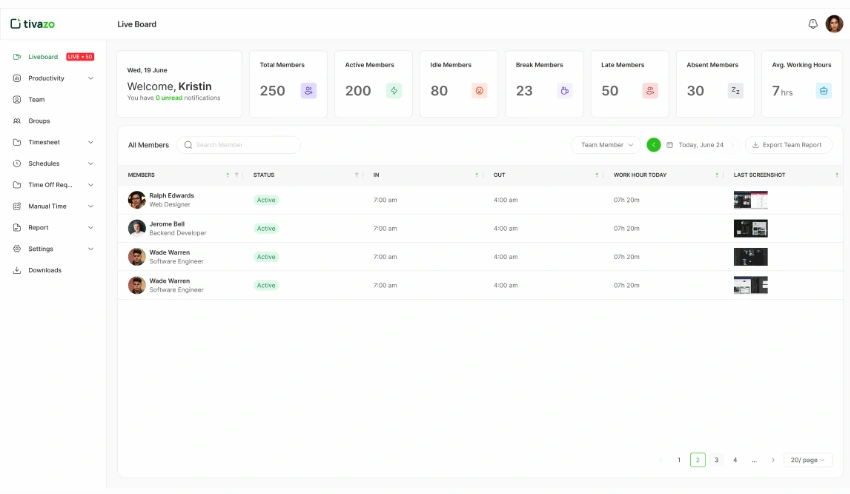The poor performance of employee can silently undermine the productivity of a team and reduce morale as well as the bottom line of your company.
The knowledge of why a worker is not performing well and what can be done to correct the situation, is an important skill to any manager. The lack of motivation, the absence of clear expectations, lack of skills, or personal issues may be reasons why employees struggle. The secret is to employ systematic plans, effective communication, and ongoing assistance to transform underperformance into a growth opportunity.
It is usually a fine line between handling the poor performance of employee. Managers need to make firm decisions without destroying workplace relationships. With early detection of warning signs, such as missed deadlines, low engagement, deteriorating work quality, and recurrent errors, larger problems can be avoided. In this blog, we will look at the ways to determine the true causes of poor performance of employee, give constructive feedback, carry out performance improvement programs, track progress, and reward improvements. These strategies will allow managers to create a sense of accountability, increase the productivity of the teams, improve the workplace culture, and assist employees in achieving their full potential.
What is a Poor Performing Employee?
Poor performing employee is the employee who constantly does not perform up to the expectations of his or her position and influences the efficiency of the team and business performance. The most typical ones are missed deadlines, poor quality of the work, frequent mistakes, and poor involvement.
Poor performance of employee may be caused by skill deficit, lack of motivation, role ambiguity in a job, or personal problems. Identification at an early stage enables the managers to give constructive feedback, mentoring, and performance improvement plans that can be used to improve employees. The identification of these signs is the initial step to enhance workplace productivity and the development of a high performing team.
What are the Causes of Poor Performance of Employee?
There is rarely any reason why poor performance of employee occurs. Managers should establish the underlying causes of the problem so that they can effectively correct it and improve the general productivity of the workplace.

1. Lack of Motivation
Lack of motivation is one of the most common reasons for the poor performance of employee. Workers who lack appreciation, feel that their efforts are not being taken into account, or do not feel that they are part of the organizational aims tend to demonstrate reduced productivity and interest.
Poor motivation may be caused by a lack of clarity in career growth, a lack of rewards, or a lack of meaningful work. These issues can be improved with the assistance of recognition programs, career development, and frequent feedback to enhance employee performance.
Read More: 7 Powerful Motivational Skills to Supercharge Your Success
2. Skill Gaps
The other significant cause of poor performance of employee is skill gaps. Employees fail to perform to the expected level when they lack the right skills or training to perform the job.
Skill gaps can be caused by poor onboarding, out-of-date training, or changing job requirements. Employees can eliminate these gaps by giving them specific training programs, mentoring, and upskilling opportunities, which can improve productivity in the workplace.
3. Personal Challenges
In some cases, low performance by an employee can be attributed to personal problems in life. An employee may be under stress, have health issues, family matters, or even financial problems, which influence his or her concentration, energy levels, and productivity.
Employers can help employees by providing flexible work hours, health and wellness programs, or counseling services. The establishment of an understanding and empathetic working environment can assist employees in coping with personal issues without compromising performance.
4. Poor Management
Another major factor that leads to poor performance of employee is ineffective management. When employees are not communicated properly, are not given realistic expectations, or have mixed feedback, they will feel lost and disengaged.
Effective leadership, goal-setting, and communication are areas that should be put in place to avoid underperformance. Through the enhancement of management practices, organizations are able to create accountability, motivation, and stability of performance among teams.
Poor performance of employee usually arises from a combination of these factors. By understanding the causes, managers can implement targeted strategies that address underlying issues, ultimately improving productivity and workplace satisfaction.
Poor Performance Of Employee Examples
Knowledge of real-life instances of poor performance of employee assists managers in identifying warning signs early in life and correcting the situation. The recognition of these patterns will help leaders to solve the problems before they become too big and adopt specific improvement efforts.
1. Missed Deadlines
Missing project deadlines is one of the typical instances of poor performance of employee. Such conduct may hamper the pace of a team, affect client satisfaction, as well as overall productivity in the workplace.
Failure to meet deadlines can be due to time management skills, unclear expectations, or because of too much work. Managers may overcome this by establishing priorities, being supportive, and monitoring progress with the aid of project management tools.
2. Low-Quality Work
Another evident example of poor performance of employee is the delivery of work that fails to meet the required standards. This may be in the form of frequent mistakes, careless write-ups, or even poor assignments that have to be redone.
Reasons may be related to the lack of skills, training, or attention to detail. Employees can be assisted to enhance the quality of output through feedback, further training, or mentoring.
3. Lack of Engagement
Poor performance of employee is a disengaged employee who exhibits low levels of participation in meetings, refuses to cooperate, or lacks initiative. Poor engagement may influence the morale and the productivity of a team.
Disengagement can be caused by poor role expectations, lack of rewards, or the feeling of being out of touch with company objectives. The managers have the chance to re-engage the employees with the help of meaningful feedback, recognition programs, and skill development opportunities.
4. Repeated Mistakes
Repeating the same mistakes is the textbook definition of poor performance of employee. This may be time-wasting, expensive, and frustrating to colleagues.
A recurrent mistake is an indication of a lack of skills, attention,/or poor instructions. Providing specific training, effective mentoring, and positive feedback will minimise errors and restore the confidence of employees.
Recognizing these examples of poor performance of employee allows managers to intervene early, provide support, and create a path toward improvement. Addressing these behaviors proactively ensures a more productive and engaged team.
Importance of Managing Poor Performance of Employee in the Workplace
Dealing with the poor performance of employee is very important in ensuring productivity, morale of employees, and overall organizational success. Underperformance also may cause more significant problems like the lack of engagement, turnover, and workplace culture degradation that should not be disregarded.
1. Boosts Team Productivity
Poor performance of employee is solved directly, thereby enhancing team productivity. With the guidance and support, employees can accomplish tasks quickly without bottlenecks and errors that can slow down the general workflow.
Such neglect of underperformance may overwhelm other teammates who have to cover the shortfalls in production. Proactive performance management helps managers to maintain a healthy workload and motivates high-performing employees to perform well.
Read More: 12 Proven Qualities of a Good Employee for Success
2. Enhances Employee Engagement
Managing the poor performance of employee effectively can boost the engagement of the team. When the employees perceive that underperformance is handled in a fair and constructive manner, they are more likely to remain motivated and committed in their work.
Employees who are engaged bring about fresh ideas, contribute to a project, and are more committed. The managers who give feedback, mentoring, and recognition contribute to a situation where everybody feels appreciated.
3. Strengthens Workplace Culture
Dealing with poor performance of employee assists in sustaining a positive and responsible culture at the workplace. The teams that discuss the issue of underperformance regularly set clear expectations and behavioral and performance standards.
This style will strengthen accountability, fairness, and respect in the workplace. A good culture in the workplace is a magnet for the best talent and minimizes conflict and enhances collaboration within the organization.
4. Reduces Employee Turnover
Dealing with the poor performance of employee will help to minimize turnover because the problem can be addressed before escalating. When employees feel motivated to enhance their performance, then the chances of them quitting out of frustration or lack of direction are low.
High turnover interferes with productivity, raises recruitment expenses, and influences team spirit. Performance management is effective when employees know what is expected of them, get the support they require, and are more likely to remain long-term.
5. Drives Organizational Success
Handling the poor performance of an employee effectively is part and parcel of the success of an organization. When individual performance is improved, efficiency increases, the project results are improved, and client satisfaction is enhanced.
Proactive management of underperformance can help organizations to meet business objectives at an accelerated rate and remain competitive. Performance management, which is structured, leads to continuous growth and a high-performing workforce.
The effective management of poor performance in employees not only enhances individual performance but also enhances team performance, engagement, and business success. Early intervention by managers will help them develop a culture of accountability and constant improvement.
📢Did You Know?
According to a report by the Wall Street Journal, the use of Performance Improvement Plans (PIPs) has increased by over 30% since 2020, highlighting their growing role in managing underperforming employees.
5 Best Action Plan For Non Performing Employees
Poor performance of employee must be tackled through a methodological process that involves diagnosing issues and offering solution-oriented ideas. An effective action plan guarantees a sense of guidance and support to the employees to improve without compromising the productivity of the entire team.

1. Identify the Root Causes
The first important step is to understand the underlying reasons that cause poor performance of employee. This can be a result of a lack of motivation, inappropriate training, personal setbacks, or bad management.
The lack of motivation is usually present in case employees think that they are not valued or not aligned with company objectives. Poor training may find the workers unready to perform as per their roles, and individual problems like health-related complications or family matters may influence concentration and productivity.
These are the factors that should be analyzed by managers objectively, possibly by holding one-on-one talks or performance evaluations. A survey showed that lack of motivation and poor management are some of the leading causes of low productivity among employees. Root cause identification enables managers to come up with focused solutions that can solve the actual problems.
2. Provide Constructive Feedback
It is important to provide feedback to a poor-performing employee so that he/she know areas that require improvement. Feedback must be precise, objective, and actionable, and must refer to behavior and not to personal qualities.
Managers are to provide specific examples of missed deadlines, low-quality work, or lack of engagement during the feedback session. Showing encouragement and readiness to help will make a safe environment in which the employees will be eager to change.
A formal feedback system not only explains expectations, but it also creates accountability. When given constructively, constructive feedback can turn around poor-performing employees and make them become productive team members.
3. Implement a Performance Improvement Plan (PIP)
A performance improvement plan is an official approach that can be used to correct a poorly performing employee. The PIP must have clear expectations, steps, and support systems depending on the needs of the employee.
Goals and standards are also clear, and this enables employees to know what is expected. Action plans, including more training, mentoring, or resources, give concrete directions for betterment.
Establishing a realistic schedule with frequent progress reviews will help to be accountable and track progress. The U.S. Chamber of Commerce says that properly planned PIPs that have quantifiable goals and follow-ups substantially enhance the likelihood of employee success.
4. Monitor Progress and Offer Support
Constant observation is essential in effectively managing the poor performance of an employee. Frequent check-ins are useful to evaluate the progress and give a chance to give more advice or change the course.
Managers are expected to review the tasks accomplished, offer positive feedback, and acknowledge small gains. Being flexible with plans will also keep the employee on track in case of difficulties or modifications to the workload.
Continued support shows that one is committed to the development of the employee, creates trust, and usually can lead to long-term performance enhancements that are beneficial to the whole team.
5. Recognize Improvements and Address Persistent Issues
Recognizing the positive change encourages good behavior in an underperforming employee. The reward for the progress will encourage employees to continue performing and boost the morale of the entire team.
But when support fails to solve the performance problems, managers should look at the suitability of the roles and whether there are alternatives within the organization. The hard choices, including reassignment or dismissal, may be needed to save the productivity of the team and organizational objectives.
The balance between recognition and accountability makes the employees feel that they are appreciated, and at the same time, there are high standards. Proactive measures to address poor performance allow managers to create a culture of steady improvement and professional development.
Inadequate employee performance can be handled through well-developed action plans, effective communication, and support. These strategies not only enhance individual performance but also enhance team productivity, engagement, and culture.
How Tivazo Helps Identify Underperforming Employees
Tivazo is an effective application that enables managers and team leads to identify poor performance of employee as soon as possible. Tivazo gives a practical view of employee productivity through understanding key performance measures, the percentage of tasks completed, and the level of engagement.
Tivazo enables managers to identify the areas in which the employees might be having issues, be it due to a lack of skills, a lack of motivation, or a workflow block, among other reasons. It is also possible to monitor changes over time on the platform, and leaders can adopt specific performance enhancement strategies.

Moreover, Tivazo allows goal setting in collaboration and feedback, so that underperforming employees know what is expected of them and work to improve their performance in measurable ways. Through the use of this tool, organizations are able to improve the accountability, engagement, and performance of their employees as a team.
Conclusion
The poor performance of employee needs to be handled in a proactive and systematic manner. It is possible to successfully address performance problems and create a productive working environment with the help of identifying root causes, constructive feedback, PIP, continued support, and acknowledgements of improvement that managers can use. It is important to keep in mind that the aim is not only to resolve the problem but to facilitate the development and success of the employee in the organization.
Are you willing to employ these strategies and turn around poor-performing employees?




